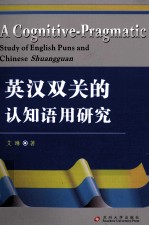

英汉双关的认知语用研究PDF电子书下载
- 电子书积分:10 积分如何计算积分?
- 作 者:艾琳著
- 出 版 社:苏州:苏州大学出版社
- 出版年份:2012
- ISBN:9787811379921
- 页数:247 页
Chapter 1 Introduction 1
1.1 A general description of English puns and Chineseshuangguan 1
1.2 Significance of studying English puns and Chineseshuangguan 8
1.3 Objectives of the present study 13
1.4 Research methodology and theoretical framework 14
1.5 Organization of the book 15
Chapter 2 Survey of the Literature 17
2.1 Introduction 17
2.2 Multidimensional approaches to the study of English puns 18
2.2.1 A rhetorical approach 18
2.2.2 A semantic approach 19
2.2.3 A relevance-theoretic approach 23
2.3 Major approaches to the study of Chineseshuangguan 30
2.3.1 A rhetorical approach 30
2.3.2 A semantic approach 32
2.3.3 A pragmatic approach 34
2.3.4 A comparative approach 37
2.4 Summary 41
Chapter 3 A Prototype-based Approach to English Puns and Chinese Shuangguan 43
3.1 Introduction 43
3.2 Prototype theory as the theoretical foundation 44
3.3 English puns:Prototypical and non-prototypical uses 48
3.4 Chinese shuangguan:Prototypical and non-prototypical uses 60
3.5 Towards a unified definition of pun in both English and Chinese 79
3.6 Summary 84
Chapter 4 Formal and Semantic Analyses of Puns in Chinese and English Talk Shows 87
4.1 Introduction 87
4.2 The data 89
4.2.1 The rationale for the choice of data from talk shows 89
4.2.2 Characteristics of the face-to-face oral communication in talk shows 91
4.2.3 Description of the data 93
4.3 A formal analysis of puns:Four prominent modes of punning 95
4.3.1 An overview of previous studies on modes of punning 95
4.3.2 Four prominent modes of punning used in talk shows 99
4.4 A semantic analysis of puns:Transparent,semi-transparent and opaque puns 125
4.5 Summary 135
Chapter 5 A Unified Account of Pun Processing 138
5.1 Introduction 138
5.2 Relevance theory 140
5.3 The graded salience hypothesis 145
5.4 Context 150
5.5 Interpretation of transparent puns 154
5.5.1 Linguistic and pragmatic features of transparent puns 154
5.5.2 Processing of transparent puns 156
5.6 Interpretation of semitransparent puns 163
5.6.1 Linguistic and pragmatic features of semitransparent puns 163
5.6.2 Processing of semitransparent puns 166
5.7 Interpretation of opaque puns 186
5.7.1 Linguistic and pragmatic features of opaque puns 186
5.7.2 Processing of opaque puns 189
5.8 Effects of different contextual cues 202
5.9 Summary 218
Chapter 6 Conclusion 223
6.1 Major findings of the present study 223
6.2 Theoretical and practical implications 232
6.3 Limitations of the study and suggestions for future research 235
Appendix 237
References 242
- 《红色旅游的社会效应研究》吴春焕著 2019
- 《汉语词汇知识与习得研究》邢红兵主编 2019
- 《生物质甘油共气化制氢基础研究》赵丽霞 2019
- 《东北民歌文化研究及艺术探析》(中国)杨清波 2019
- 《联吡啶基钌光敏染料的结构与性能的理论研究》李明霞 2019
- 《异质性条件下技术创新最优市场结构研究 以中国高技术产业为例》千慧雄 2019
- 《法语词汇认知联想记忆法》刘莲编著 2020
- 《《国语》和《战国策》词汇比较研究》陈长书著 2017
- 《中国制造业绿色供应链发展研究报告》中国电子信息产业发展研究院 2019
- 《行政保留研究》门中敬著 2019
- 《中风偏瘫 脑萎缩 痴呆 最新治疗原则与方法》孙作东著 2004
- 《水面舰艇编队作战运筹分析》谭安胜著 2009
- 《王蒙文集 新版 35 评点《红楼梦》 上》王蒙著 2020
- 《TED说话的力量 世界优秀演讲者的口才秘诀》(坦桑)阿卡什·P.卡里亚著 2019
- 《燕堂夜话》蒋忠和著 2019
- 《经久》静水边著 2019
- 《魔法销售台词》(美)埃尔默·惠勒著 2019
- 《微表情密码》(波)卡西亚·韦佐夫斯基,(波)帕特里克·韦佐夫斯基著 2019
- 《看书琐记与作文秘诀》鲁迅著 2019
- 《酒国》莫言著 2019
- 《大学计算机实验指导及习题解答》曹成志,宋长龙 2019
- 《大学生心理健康与人生发展》王琳责任编辑;(中国)肖宇 2019
- 《大学英语四级考试全真试题 标准模拟 四级》汪开虎主编 2012
- 《大学英语教学的跨文化交际视角研究与创新发展》许丽云,刘枫,尚利明著 2020
- 《复旦大学新闻学院教授学术丛书 新闻实务随想录》刘海贵 2019
- 《大学英语综合教程 1》王佃春,骆敏主编 2015
- 《大学物理简明教程 下 第2版》施卫主编 2020
- 《大学化学实验》李爱勤,侯学会主编 2016
- 《中国十大出版家》王震,贺越明著 1991
- 《近代民营出版机构的英语函授教育 以“商务、中华、开明”函授学校为个案 1915年-1946年版》丁伟 2017
